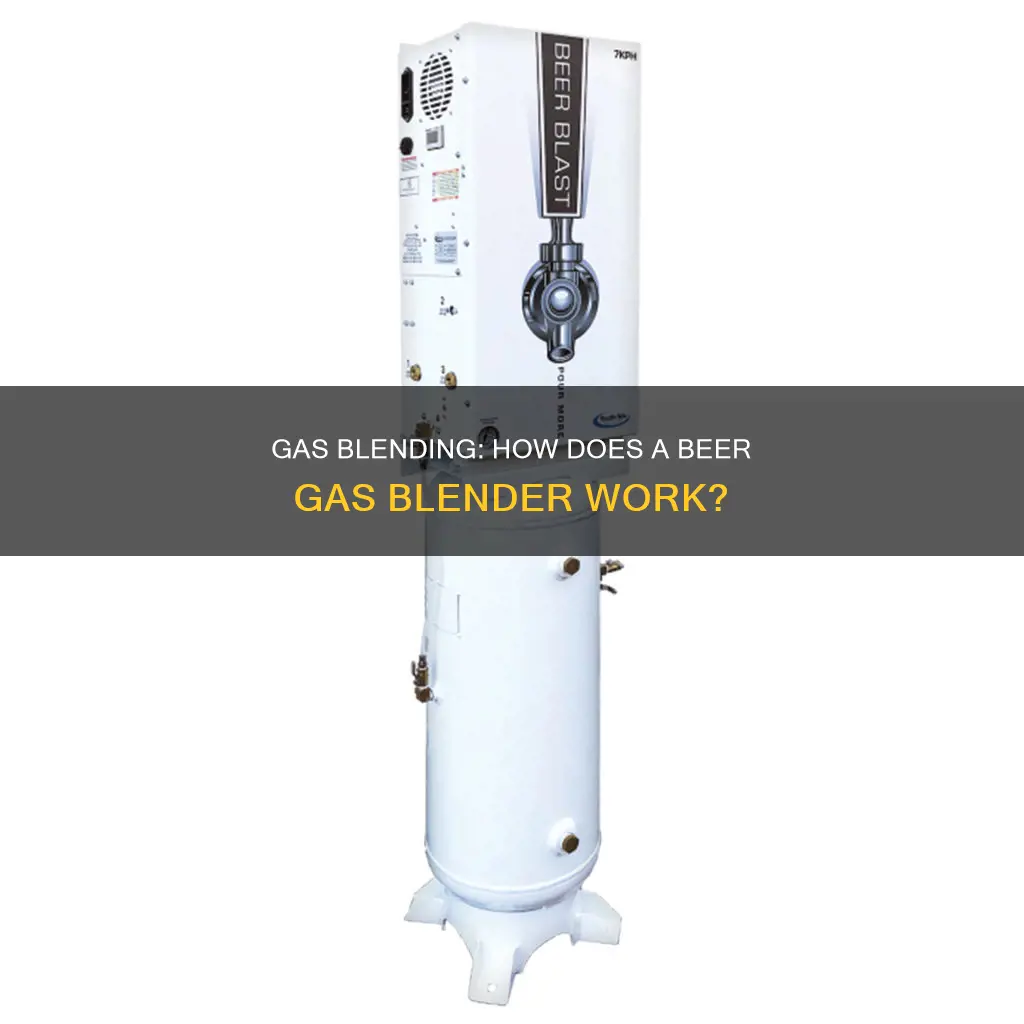
A beer gas blender is a device that blends gas for a beer system. It takes in carbon dioxide (CO2) and nitrogen (N) through its inputs and blends them to the right mix. The blended gas is then dispensed downstream to be used in draft beer systems. The purpose of a beer gas blender is to maintain the correct carbonation levels in the beer and to prevent it from becoming flat or foamy. By using a blend of CO2 and nitrogen, the beer's carbonation levels can be kept in equilibrium, resulting in a perfect pint every time.
| Characteristics | Values |
|---|---|
| Purpose | Blends gas for beer systems to prevent foamy beer |
| Input gases | CO2 and Nitrogen |
| Input pressure | Minimum: 50 psi; Maximum: 150 psi |
| Output | Dispenses the prescribed blend downstream for a beer system |
| Mixture | Different mixtures or blends; some blenders can mix up to 3 different blends |
| Input location | Two inputs, usually at the bottom of the unit on either side |
| Connection | High-pressure braided airline; 3/8" I.D hose with sized 16.2 otiker clamps |
| Troubleshooting | Check valves are in the open position, pressure is set correctly, and the CO2 and Nitrogen tanks are not empty |
| Outgoing pressure | Around 50 psi |
| Adjustment | Some blenders have an adjustment knob; others are pre-set with an exiting pressure of 47 psi |
| Setup | Some have one blended gas, while others have multiple blends |
| Leak detection | Some blenders have built-in leak detectors |
What You'll Learn
- Gas blenders mix CO2 and nitrogen to dispense draft beer
- Blended gas technology protects the integrity of the product from keg to glass
- Pure CO2 is the cheapest gas, but a blender can reduce waste to zero
- Gas blenders are accurate and can be tamper-proof and fully automatic
- The right beer gas depends on factors such as the style of beer, temperature, carbonation and pressure

Gas blenders mix CO2 and nitrogen to dispense draft beer
Gas blenders are an essential component of draft beer systems, playing a crucial role in maintaining the perfect balance of carbonation and delivering a great-tasting beer. By mixing carbon dioxide (CO2) and nitrogen (N2) gases, gas blenders ensure that the beer stays in equilibrium, preventing it from becoming flat or overly gassy.
The process begins with the blender taking in CO2 and nitrogen through its inputs, usually located at the bottom of the unit. It then blends these gases to the desired ratio, which can vary depending on the type of beer being dispensed. The blended gas is then dispensed downstream to the draft beer system, ensuring a consistent and ideal level of carbonation.
One of the key advantages of using a gas blender is the ability to achieve the correct blend of CO2 and nitrogen. CO2 is a natural byproduct of the brewing process and plays a significant role in flavour development. However, if the CO2 partial pressure in the mix is too low, the beer can go flat. On the other hand, if the CO2 partial pressure is too high, the beer can become over-carbonated, resulting in excess foam and flavour changes. By using a gas blender, the correct blended gas ratio can be maintained, ensuring the beer stays in equilibrium.
Additionally, gas blenders offer cost savings and flexibility. Pure CO2, while cheaper, can result in significant beer wastage due to over-carbonation. By blending CO2 with nitrogen, gas blenders reduce wastage to zero, saving establishments money in the long run. Furthermore, with a gas blender, there is no need to rely on pre-mixed gas cylinders, which can be expensive and may not always provide the right gas ratio. With a blender, you simply purchase pure carbon dioxide and nitrogen, allowing you to create the desired blend on-site.
Overall, gas blenders provide an efficient and cost-effective solution for dispensing draft beer. By mixing CO2 and nitrogen to the right ratio, they ensure the beer stays carbonated at the ideal level, enhancing the flavour and presentation of the beer. By investing in a gas blender, establishments can improve the quality of their draft beer offerings while also reducing waste and saving on costs.
The Magic Behind Draft Beer: Bar System Explained
You may want to see also

Blended gas technology protects the integrity of the product from keg to glass
Blended gas technology is an essential tool for protecting the integrity of beer from keg to glass. The process involves mixing carbon dioxide (CO2) and nitrogen (N) gases to dispense draft beer. This technique was initially used for dispensing stout or nitrogenated (nitro) draft beers, such as Guinness, but has since become popular for ales and lagers as well. By using a blend of CO2 and nitrogen, the correct presentation and flavor of the beer can be achieved.
One of the key benefits of blended gas technology is maintaining the right carbonation levels in the beer. CO2 is an essential ingredient in the brewing process, and its partial pressure in the gas mix is critical. If the CO2 partial pressure is too low, the beer will go flat. On the other hand, if the CO2 partial pressure is too high, it will lead to over-carbonation, resulting in excess foam and performance issues. By using blended gas technology, the correct CO2/nitrogen ratio can be maintained, ensuring that the beer stays in equilibrium and preserving its flavor and quality.
Another advantage of blended gas technology is cost savings. Pure CO2, while the cheapest gas option, can create significant waste in bars, leading to up to 58 kegs of wasted beer per year. On the other hand, pre-mixed gas cylinders can be expensive and may not always have the right blend ratio. Blended gas technology allows you to buy pure carbon dioxide and nitrogen separately, and then mix them to the desired ratio, resulting in significant cost savings over time.
Additionally, blended gas technology offers flexibility in dispensing different types of beer. The CO2/nitrogen ratio can be adjusted based on the style of beer, ensuring that each type of beer is dispensed at the correct pressure and carbonation level. This flexibility ensures that the flavor, quality, and performance of the beer are maintained during dispensing, regardless of the style.
Overall, blended gas technology plays a crucial role in maintaining the integrity of beer from keg to glass. By ensuring the correct gas mix, carbonation levels, and dispensing pressure, this technology helps preserve the flavor, quality, and presentation of the beer, while also reducing waste and costs for establishments.
Shotgunning Beer: How to Chug Instantly
You may want to see also

Pure CO2 is the cheapest gas, but a blender can reduce waste to zero
Pure CO2 is the cheapest gas to use in bars, but it can create a lot of waste. Using a beer gas blender can reduce waste to zero and only costs pennies per keg.
A beer gas blender is a piece of equipment that blends gas for a beer system. It takes in CO2 and nitrogen and dispenses the prescribed blend downstream so there's no foamy beer. The blended gas comes in different mixtures or blends, with some blenders being able to mix up to 3 different blends.
The most common blend is 70% CO2 and 30% nitrogen, which is used for beers, ales, and lagers. This blend allows the establishment to increase the applied pressure up to about 24 lbs. This blend is normally used when the applied pressure of gas exceeds 16 psi.
CO2 applied at a higher pressure will over-carbonate the beer, leading to foaming and loss of product. A blend with more CO2 and less nitrogen is needed to maintain the beer's flavor, quality, and performance during dispensing.
Premixed gas cylinders are expensive and can vary in blend ratios. With a blender, you simply buy pure carbon dioxide and pure nitrogen, and the blender does the rest. You save money in the long run and reduce waste to zero.
A gas blender can often pay for itself within a single month. It is also tamper-proof and fully automatic.
Beer, Anxiety, and You: A Curious Concoction
You may want to see also

Gas blenders are accurate and can be tamper-proof and fully automatic
Gas blenders are highly accurate, with some models guaranteeing accuracy within 2%. This precision ensures that carbonation levels remain consistent over time, maintaining the quality of the beer. Each blender is individually tested before leaving the manufacturer to ensure its accuracy.
In addition to accuracy, some gas blenders also offer tamper-proof features. For example, Micro Matic blenders are designed to be tamper-proof, providing peace of mind and ensuring the integrity of the beer-dispensing process. This feature is particularly important in commercial settings, where maintaining consistent beer quality is crucial for customer satisfaction and maintaining brand reputation.
Furthermore, gas blenders can be fully automatic, simplifying the beer-dispensing process. The McDantum Trumix Blender, for instance, is a fully automatic blender made specifically for dispensing beer. It is engineered to be free of parts vulnerable to wear, ensuring a long lifespan of reliable performance. This blender is constructed with durable materials such as brass, stainless steel, aluminium, and plastics, which offer excellent resistance to aging or corrosion in the typical N2 and CO2 atmosphere.
The combination of accuracy, tamper-proof design, and full automation in gas blenders provides a reliable and consistent beer-dispensing solution for bars, restaurants, and other establishments serving draught beer. By ensuring the correct gas mixture and maintaining proper carbonation levels, these blenders help deliver a high-quality beer-drinking experience for customers while reducing waste and saving costs for businesses.
The Science of Beer Tubes: How Do They Work?
You may want to see also

The right beer gas depends on factors such as the style of beer, temperature, carbonation and pressure
The right blend of beer gas depends on a variety of factors, including the style of beer, temperature, carbonation, and pressure.
Different styles of beer have different carbonation requirements, with light lagers generally having higher carbonation levels and more volumes of CO2, while stouts tend to have lower carbonation. The carbonation level of beer is measured in volumes of CO2, which indicates how many times the volume of CO2 at atmospheric pressure would fit into the same volume of liquid. Ales and lagers typically have carbonation units ranging from 2.2 to 2.8 volumes, while stouts can range from 1.2 to 1.7 volumes.
The temperature of the beer also plays a crucial role in determining the right blend of beer gas. Colder temperatures allow for faster absorption of CO2, and the ideal liquid temperature for beer is considered to be around 38°F, as it is desirable for consumption and provides stable CO2 levels.
Carbonation is another important factor, as it gives beer its distinctive mouthfeel and affects its texture, taste, and drinkability. The right blend of beer gas should maintain the desired carbonation level for each beer style. Over-carbonation can lead to excessive foaming, while under-carbonation can result in flat beer.
Additionally, the pressure applied to the keg, typically measured in pounds per square inch (PSI), is a key factor in determining the right blend of beer gas. Different beer styles require different pressure settings to accurately represent their intended flavor and carbonation levels. For example, ales, ambers, and pale ales are usually dispensed at 10-12 PSI, while lagers, pilsners, and wheat beers are served at slightly higher pressures of 12-14 PSI.
By taking into account the style of beer, temperature, carbonation, and pressure, the right blend of beer gas can be determined to ensure optimal taste, presentation, and carbonation levels for each specific beer.
Underground Beer Coolers: Do They Keep Drinks Chilled?
You may want to see also
Frequently asked questions
A beer gas blender is a piece of equipment that blends gas for a beer system. It takes in CO2 and Nitrogen and dispenses the prescribed blend downstream to prevent foamy beer.
A beer gas blender will have two inputs, usually at the bottom of the unit on either side, for Nitrogen and CO2. The gas sources are connected to the blender using a high-pressure braided airline. The blender requires a minimum pressure of around 50 psi for its inputs.
Using a beer gas blender can save time and money, especially when used for nitro beers, as pre-mixed cylinders are expensive and need to be changed often. Blenders can reduce waste to zero and only cost pennies per keg.
The ideal blend of beer gas depends on factors such as the style of beer, temperature of the beer cooler, carbonation of the beer, system resistance, and the total applied pressure required. For example, Guinness gas is a mix of 25% CO2 and 75% Nitrogen, while ales and lagers use a 70% CO2 and 30% Nitrogen blend.







